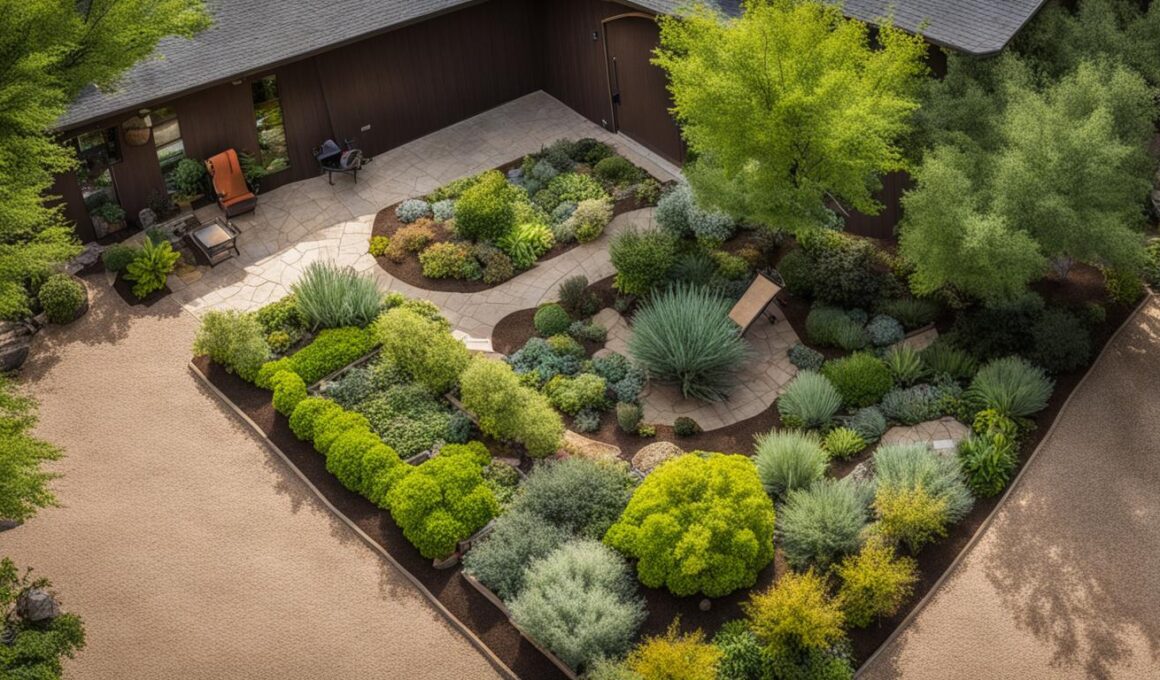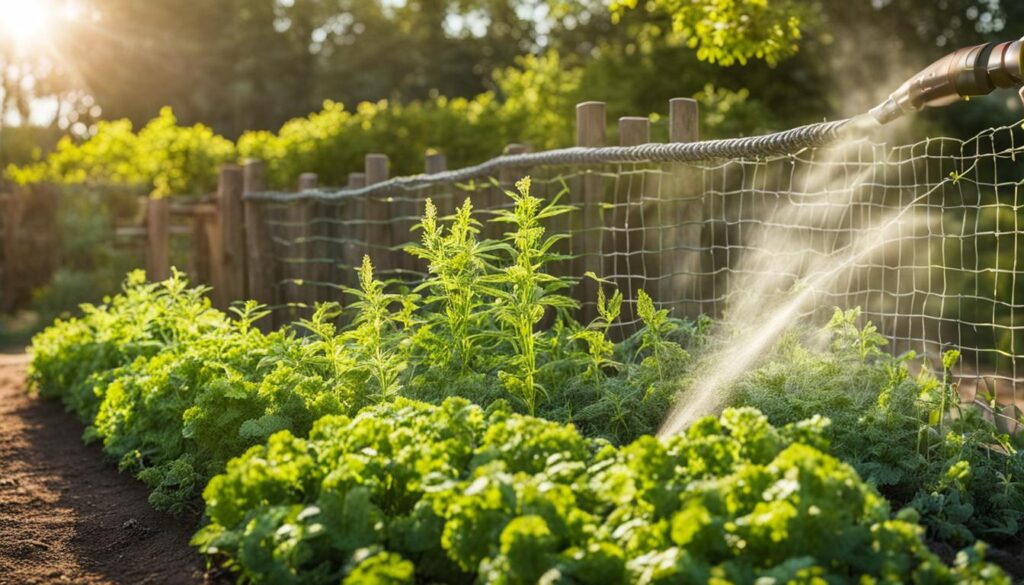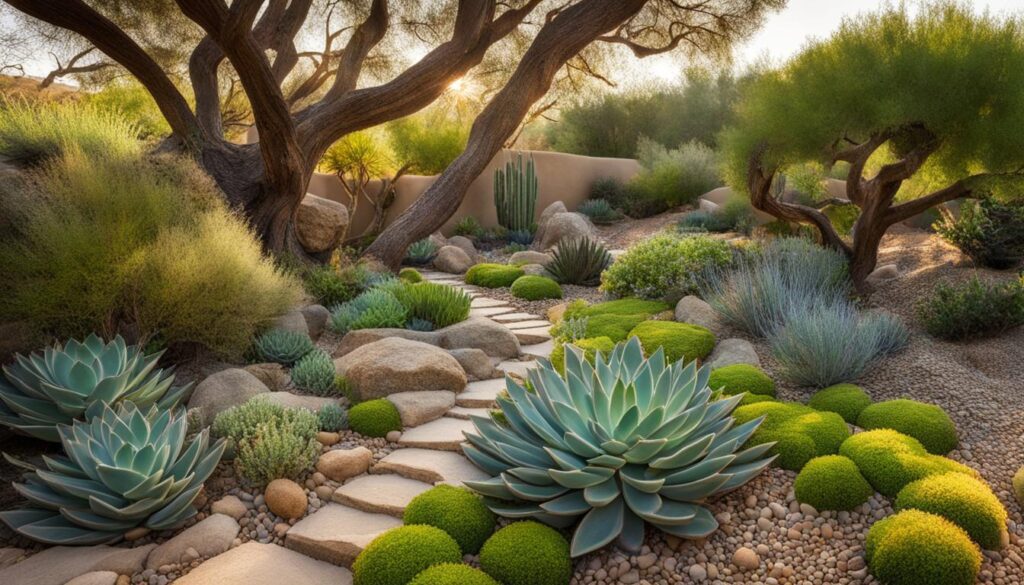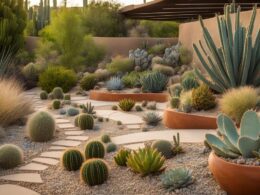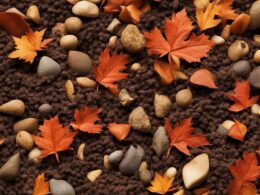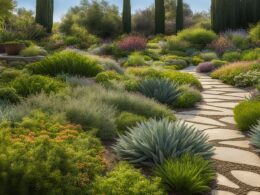Xeriscape ground cover maintenance is essential for creating and maintaining a beautiful, eco-friendly outdoor space. By utilizing water-efficient landscaping techniques, you can reduce water consumption and create a sustainable landscape. Here are some facts about xeriscape ground cover maintenance:
Key Takeaways:
- Xeriscape ground cover maintenance helps create a sustainable and eco-friendly outdoor space.
- Water-efficient landscaping techniques can reduce water consumption.
- Proper maintenance ensures the growth and appearance of xeriscape ground covers.
- Choose drought-tolerant ground cover plants for a beautiful and low-maintenance landscape.
- Controlling weeds is crucial for the success of xeriscape ground cover plants.
Xeriscape Ground Cover Benefits
When it comes to creating a beautiful, eco-friendly outdoor space, xeriscape ground covers offer numerous benefits. These water-efficient landscaping options not only help conserve water but also reduce soil erosion, making them an excellent choice for sustainable landscapes.
One of the key advantages of xeriscape ground covers is their ability to reduce soil erosion. Their dense root systems help hold the soil in place, preventing it from being washed away during heavy rainfall or irrigation. This not only protects the integrity of your landscape but also minimizes sediment runoff into nearby water sources.
In addition to their functional benefits, xeriscape ground covers also provide ornamental features that enhance the aesthetic appeal of your outdoor space. With a wide range of colors, textures, and heights to choose from, you can create visually stunning landscapes that are both drought-tolerant and visually appealing.
Key Benefits of Xeriscape Ground Covers:
- Water-efficient landscaping that helps conserve water
- Reduces soil erosion by holding soil in place
- Offers a wide range of ornamental features for visual appeal
- Drought-tolerant and low-maintenance
- Creates a sustainable landscape
By incorporating xeriscape ground covers into your landscape design, you can enjoy the benefits of water-efficient landscaping while reducing soil erosion and adding ornamental features to your outdoor space. These versatile ground covers provide a sustainable solution that not only helps conserve water but also enhances the overall beauty of your landscape.
Suitable Soils and Exposure for Xeriscape Ground Covers
Choosing the right soil and exposure is crucial for the success of your xeriscape ground cover plants. Proper soil preparation, good aeration, and drainage are key factors in ensuring healthy growth.
When it comes to soil preparation, make sure to amend the existing soil with organic matter to improve its texture and water-holding capacity. This will provide a favorable environment for the roots to establish and thrive. Additionally, incorporating compost or well-rotted manure into the soil can help enrich it with essential nutrients.
Good aeration and drainage are essential for xeriscape ground covers. These plants prefer well-drained soil to avoid waterlogging, which can lead to root rot. If your soil tends to retain water, consider adding perlite or pumice to improve drainage. Additionally, planting ground covers in raised beds or mounds can help enhance drainage.
The exposure of your xeriscape ground covers to sunlight is another important consideration. Some ground covers thrive in full sun, while others prefer shady conditions. Before selecting your plant varieties, assess the amount of sunlight your garden receives throughout the day. This will help you choose the right plants that can thrive in the available light conditions.
Weed Control and Maintenance Tips
Proper weed control and maintenance are crucial for ensuring the health and vitality of your xeriscape ground covers. By implementing effective weed control strategies, you can minimize competition for resources and promote the growth of your desired plants. Here are some helpful tips:
1. Use Weed Barrier Fabrics
One effective method to prevent weeds from emerging is to use weed barrier fabrics. These fabrics create a physical barrier between the soil and the surface, preventing weed seeds from germinating. Make sure to choose a fabric that allows water to penetrate while blocking sunlight to ensure the best results. Install the fabric before planting your ground covers, securing it firmly with landscape staples.
2. Mulch, Mulch, Mulch
Mulching is another essential practice for weed control in xeriscape ground cover areas. Apply a layer of organic mulch, such as wood chips, straw, or compost, around your plants. Mulch helps to suppress weed growth by shading the soil, preventing weed seeds from receiving the light they need to germinate. Additionally, mulch retains moisture in the soil, reducing the need for frequent watering.
3. Choose Low-Growing Ground Covers
Selecting low-growing ground covers can also aid in weed control. These plants form dense mats that shade the soil and prevent weed seeds from germinating. Examples of low-growing ground covers suitable for xeriscapes include creeping thyme, woolly thyme, and creeping phlox. Consult with a local nursery or horticulturist to determine the best options for your specific region.
By employing these weed control and maintenance tips, you can create a thriving xeriscape ground cover area that is not only beautiful but also low-maintenance. Remember to regularly inspect your plants for any signs of weed growth and promptly remove any unwanted plants to maintain the integrity of your xeriscape design.
How Much Does Ground Cover Maintenance Contribute to Overall Xeriscape Maintenance Costs?
When considering xeriscape maintenance costs, the impact of ground cover maintenance should not be overlooked. This xeriscape maintenance cost estimation article explores how the care of ground cover, such as mulch or gravel, can significantly contribute to the overall expenses of maintaining a xeriscape landscape.
Popular Xeriscape Ground Cover Plants
When it comes to xeriscape ground covers, there are several popular plant options that offer both beauty and drought tolerance. These plants are not only low-maintenance but also provide excellent ground coverage while conserving water. Here are a few examples:
- ‘Angelina’ Sedum: With its vibrant yellow-green foliage, ‘Angelina’ Sedum adds a pop of color to any xeriscape garden. This tough ground cover plant is drought-tolerant and thrives in full sun. Its succulent leaves retain moisture, making it an excellent choice for water-conscious landscaping.
- Blue Fescue Grass: Blue Fescue Grass is known for its stunning blue-gray color and fine-textured foliage. This ornamental grass forms dense clumps that help prevent soil erosion and add visual interest to your xeriscape garden. It is a hardy plant that requires minimal water once established.
- Creeping Mahonia: Creeping Mahonia is a versatile ground cover plant that offers year-round interest. Its glossy evergreen leaves provide an attractive backdrop for the bright yellow flowers that bloom in winter. This drought-tolerant plant also produces edible, grape-like berries.
- Dianthus ‘Firewitch’: Known for its vibrant magenta flowers and spicy fragrance, Dianthus ‘Firewitch’ is a popular choice for xeriscape gardens. This low-growing ground cover plant thrives in full sun and well-draining soil. It requires minimal water and is deer resistant, making it a great addition to any water-efficient landscape.
These are just a few examples of the many xeriscape ground cover plants available. Each plant has its unique characteristics and advantages, but they all share the ability to withstand drought conditions and reduce water consumption. Incorporating these plants into your xeriscape garden will not only help you create a beautiful and sustainable landscape but also save water in the process.
Creating a Stunning Xeriscape Garden
To create a stunning xeriscape garden, consider combining different types of ground cover plants. By incorporating a mix of colors, textures, and heights, you can create an eye-catching landscape that is both visually appealing and environmentally friendly. Use taller plants as focal points or to provide vertical interest, while low-growing ground covers can fill in gaps and provide a seamless carpet of foliage.
Additionally, be sure to choose ground cover plants that are suited to your specific climate and soil conditions. This will ensure their success and longevity in your xeriscape garden. Remember to provide proper irrigation during the establishment phase, but once the plants are established, they will require less water and maintenance compared to traditional turfgrasses.
Conclusion
Xeriscape ground cover maintenance is crucial for creating and sustaining a beautiful and eco-friendly outdoor space. By implementing water-efficient landscaping techniques, you can reduce water consumption and establish a sustainable landscape that benefits both you and the environment.
Choosing drought-tolerant ground cover plants and properly preparing the soil are key factors in the success of your xeriscape project. By selecting the right plants and ensuring good soil aeration and drainage, you can create an optimal environment for your ground covers to thrive.
In addition, controlling weeds and providing regular maintenance are essential for the growth and appearance of your xeriscape ground covers. Utilizing weed barrier fabrics, mulching, and incorporating low-growing ground covers can help suppress weed growth and minimize maintenance efforts.
By incorporating xeriscape ground cover maintenance practices into your landscaping, you not only conserve water but also enjoy the added benefits of preventing soil erosion and enhancing the visual appeal of your outdoor space. Create a sustainable and beautiful landscape by embracing xeriscape ground covers, and take pride in contributing to a water-efficient and eco-friendly environment.





